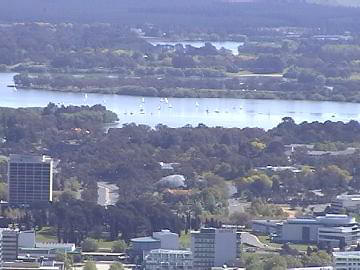CANBERRA, A.C.T.

Contrary to popular belief,
the capital city of
Australia
is not Sydney or Melbourne,
but Canberra
A.C.T.
The initials stand for
Australian Capital
Territory.
Again, not much, if anything,
is mentioned of Canberra
in American school systems,
and the focus is placed
on
the other cities;
but I believe Canberra to be one
of
the most unusual cities
I have ever visited.
Canberra is still growing,
with a population of
over 300,000 people.
It is home of the national
Parliament and seat of government,
and has an international appeal.
Almost 80 diplomatic missions
make their home here,
many built in their national
style.
Today, Canberra is very much a planned city,
but
has overstepped the boundaries
originally set by
designer Walter Burley Griffin.
However, the major
elements remain:
the hilltops are retained as
conservation parks and wildlife reserves,
Lake Burley
Griffin still links
the north to the south of the city
visually,
and the Parliamentary Triangle
of national
buildings remains a brilliant focal point.
Initially populated mainly by public servants,
Canberra today is a city
of a diverse population,
and
truly lives up to the meaning of its name-
meeting
place.
It is possible to travel
from a snow-capped
mountain top
to a tropical rainforest all in less than
one hour.
As all capital cities must have a port,
and
Canberra is inland,
Jervis Bay was named a part of the
A.C.T. to serve as that port.
It is approximately
2 1/2 hours from the main city.
Check out some of the sites
in and around Canberra in the next few pages.
I think you will see what I mean.
   

|